

Storytelling. ITALY DOCENTI PEARSON ACADEMY 2016 Pearson Education Library PDF Storytelling, adesso vi racconto una storia. 22 forme di narrazione per scrittori e storyteller. Quanti modi esistono per raccontare una storia?
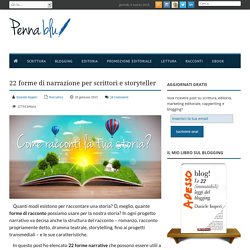
O, meglio, quante forme di racconto possiamo usare per la nostra storia? Storytelling: Inventafavole, carte di Propp e Tavola della Narrazione. Storytelling in classe: gli strumenti per le nostre storie - GRIMPO! Le storie potenti e commoventi sono fondamentali per la nostra esistenza.
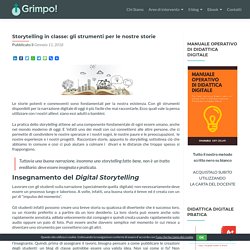
Con gli strumenti disponibili per la narrazione digitale di oggi è più facile che mai raccontarle. Ecco quali vale la pensa utilizzare con i nostri allievi: siano essi adulti o bambini. La pratica dello storytelling attiene ad una componente fondamentale di ogni essere umano, anche nel mondo moderno di oggi. Suggestion Box. Insert summary here...
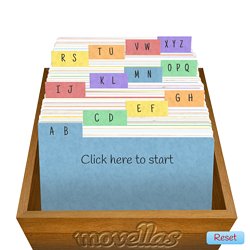
02 Ascione Cusmai Quagliata La narrazione a supporto. TCH hyvarinen. SEVEN STEPS TO THE PERFECT STORY – The Home of Content Marketing in Online, M... The cognitive importance of storytelling - Christopher S. Penn Marketing Blog. Last week, I shared Dr.
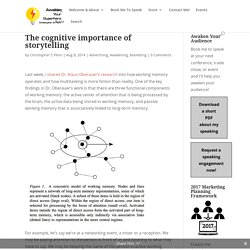
Klaus Oberauer’s research into how working memory operates and how multitasking is more fiction than reality. One of the key findings in Dr. Oberauer’s work is that there are three functional components of working memory: the active center of attention that is being processed by the brain, the active data being stored in working memory, and passive working memory that is associatively linked to long-term memory. For example, let’s say we’re at a networking event, a mixer or a reception. We may be paying attention to the person in front of us and listening to what they have to say. The answer is in Dr.
So what does this have to do with storytelling? This is one of the many reasons that content marketing using pop culture is so powerful and effective; you’re essentially using existing stories and the pre-formed associations to quickly build more links from active working memory to passive working memory to long-term memory. How to teach ... storytelling. Once upon a time (16 years ago, to be precise), National Storytelling Week was born.
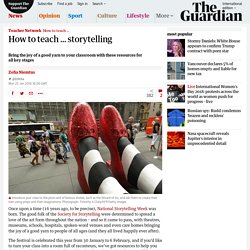
The good folk of the Society for Storytelling were determined to spread a love of the art form throughout the nation – and so it came to pass, with theatres, museums, schools, hospitals, spoken-word venues and even care homes bringing the joy of a good yarn to people of all ages (and they all lived happily ever after). The festival is celebrated this year from 30 January to 6 February, and if you’d like to turn your class into a room full of raconteurs, we’ve got resources to help you do it. A good place to start is this guide, also from the Society for Storytelling, on the educational processes that take place as children learn from hearing and engaging with stories.
This guide for parents can also be handed out to encourage storytelling at home. Primary. "The Periodic Table of Storytelling" Reveals the Elements of Telling a Good S... Dmitri Mendeleev might have designed the original periodic table – a graphic representation of all the basic building blocks of the universe – but artist James Harris has done something way cool with that template -- the Periodic Table of Storytelling.

That’s right. Harris has taken all the tropes, archetypes and clichés found in movies (not to mention TV, comic books, literature, video and even professional wrestling) and synthesized them into an elegantly realized chart. Instead of grouping the elements by noble gases or metals, Harris has organized them by story elements -- structure, plot devices, hero archetypes. Each element is linked to a vast wiki that gives definitions and examples. For instance, if you click on the element Chk, you’ll go to a page explaining the trope of Chekhov’s Gun. Below the chart, Harris has even created story molecules for a few specific movies.
Via No Film School Related Content: Periodic Table of Storytelling. Storytelling infographic : What really makes a good story? In a recent post, I noted that the term ‘storytelling’ is being applied to more and more types of content, not all of them proper stories. On top of that, there’s often an over-emphasis on the channels and media used for storytelling at the expense of the stories themselves. But all that begs the question: what does make a good story? This post draws on academic research into political storytelling, and other sources, to argue that the most effective commercial stories share seven closely related characteristics: drama, familiarity, simplicity, immersion, relatability, agency and trust in the teller. (Discussion continues below infographic.) Drama Stories need dramatic development and emotional dynamics. At the very broadest level, drama is the spark that animates all creative forms of advertising and marketing.
Just as drama turns a benefit into a creative concept, so it turns a neutral sequence of events into a story. 8 Classic storytelling techniques for engaging presentations. Cookbook. Le-carte-di-propp. Networked Knowledge and Combinatorial Creativity. By Maria Popova In May, I had the pleasure of speaking at the wonderful Creative Mornings free lecture series masterminded by my studiomate Tina of Swiss Miss fame.
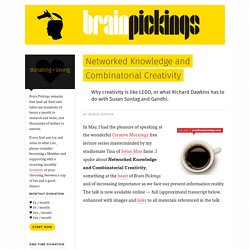
I spoke about Networked Knowledge and Combinatorial Creativity, something at the heart of Brain Pickings and of increasing importance as we face our present information reality. The talk is now available online — full (approximate) transcript below, enhanced with images and links to all materials referenced in the talk. These are pages from the most famous florilegium, completed by Thomas of Ireland in the 14th century. Florilegia were compilations of excerpts from other writings, essentially mashing up selected passages and connecting dots from existing texts to illuminate a specific topic or doctrine or idea.
In talking about these medieval manuscripts, Adam Gopnik writes in The New Yorker: